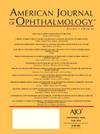Complications and Management of Cosmetic Iris Implants
IF 4.1
1区 医学
Q1 OPHTHALMOLOGY
引用次数: 0
Abstract
Objective
To evaluate the complications, management, and outcomes associated with cosmetic iris implants.
Design
Single-center retrospective interventional case series.
Subjects
30 eyes of 15 patients who presented to Moorfields Eye Hospital, London, UK with complications related to cosmetic iris implants between January 2008 and December 2023. Mean age at implantation was 34.13 ± 9.51 years, with predominantly Asian ethnicity (53%) and male gender (60%).
Methods
Medical records were reviewed for patient demographics, pre-explantation parameters, complications, management, and outcomes. Best-corrected visual acuity (BCVA), intraocular pressure (IOP), endothelial cell count (ECC), and central corneal thickness (CCT) were analyzed before and after explantation. Secondary interventions were documented, and statistical analyses were performed using paired t-tests and Pearson correlation coefficients.
Main Outcome Measures
BCVA, IOP, ECC, CCT, presence of uveitis, glaucoma, corneal decompensation, cataract formation, and need for secondary surgical interventions.
Results
Median time to explantation was 45.5 months (range: 6.0-140.1 months). The most common complications included uveitis (60%), elevated IOP requiring glaucoma surgery (33.3%), corneal decompensation requiring Descemet's Membrane Endothelial Keratoplasty (20%), and cataract formation requiring phacoemulsification (13.3%). A statistically significant positive correlation was found between time to explantation and corneal decompensation (r = 0.392, P = .048). In patients who underwent DMEK (n=6), ECC increased significantly from 778.33 ± 191.53 cells/mm² to 1107.33 ± 17.96 cells/mm² postoperatively (P = .009), and mean CCT decreased from 783.17 ± 293.93 µm to 508.83 ± 48.94 µm (P = .1). Despite these interventions, a considerable proportion of patients experienced persisting symptoms requiring secondary surgery.
Conclusions
This case series demonstrates that cosmetic iris implants are associated with serious sight-threatening complications including corneal decompensation, glaucoma, and uveitis. Many patients required multiple surgical interventions after explantation, highlighting the long-term morbidity associated with these devices. The authors recommend that cosmetic iris implantation should be banned worldwide given the substantial risks and lack of therapeutic value, and greater regulatory oversight is needed to prevent further harm to patients.
美容虹膜植入的并发症及处理。
目的:探讨美容虹膜植入的并发症、处理方法及预后。设计:单中心回顾性介入病例系列。研究对象:2008年1月至2023年12月在英国伦敦Moorfields眼科医院就诊的15例伴有虹膜植入手术并发症的患者,共30只眼。平均着床年龄34.13±9.51岁,以亚裔(53%)和男性(60%)为主。方法:回顾患者的人口统计资料、外植体前参数、并发症、处理和结果。分析最佳矫正视力(BCVA)、眼内压(IOP)、内皮细胞计数(ECC)和角膜中央厚度(CCT)。对二次干预进行记录,并使用配对t检验和Pearson相关系数进行统计分析。主要观察指标:BCVA、IOP、ECC、CCT、是否存在葡萄膜炎、青光眼、角膜失代偿、白内障形成、是否需要二次手术干预。结果:中位离体时间为45.5个月(范围:6.0-140.1个月)。最常见的并发症包括葡萄膜炎(60%),需要青光眼手术的IOP升高(33.3%),需要Descemet膜内皮角膜移植术的角膜失代偿(20%)和需要超声乳化手术的白内障形成(13.3%)。植体时间与角膜失代偿呈显著正相关(r = 0.392,p = 0.048)。在DMEK患者中(n=6),术后ECC从778.33±191.53 cells/mm²显著增加到1107.33±17.96 cells/mm²(p=0.009),平均CCT从783.17±293.93 μm下降到508.83±48.94 μm (p=0.1)。尽管有这些干预措施,相当大比例的患者经历持续的症状需要二次手术。结论:本病例系列表明,美容性虹膜植入与严重的视力威胁并发症有关,包括角膜失代偿、青光眼和葡萄膜炎。许多患者在移植后需要多次手术干预,突出了这些装置的长期发病率。作者建议,鉴于存在巨大的风险和缺乏治疗价值,整容虹膜植入应该在全球范围内被禁止,并且需要更大的监管监督来防止对患者的进一步伤害。
本文章由计算机程序翻译,如有差异,请以英文原文为准。
求助全文
约1分钟内获得全文
求助全文
来源期刊
CiteScore
9.20
自引率
7.10%
发文量
406
审稿时长
36 days
期刊介绍:
The American Journal of Ophthalmology is a peer-reviewed, scientific publication that welcomes the submission of original, previously unpublished manuscripts directed to ophthalmologists and visual science specialists describing clinical investigations, clinical observations, and clinically relevant laboratory investigations. Published monthly since 1884, the full text of the American Journal of Ophthalmology and supplementary material are also presented online at www.AJO.com and on ScienceDirect.
The American Journal of Ophthalmology publishes Full-Length Articles, Perspectives, Editorials, Correspondences, Books Reports and Announcements. Brief Reports and Case Reports are no longer published. We recommend submitting Brief Reports and Case Reports to our companion publication, the American Journal of Ophthalmology Case Reports.
Manuscripts are accepted with the understanding that they have not been and will not be published elsewhere substantially in any format, and that there are no ethical problems with the content or data collection. Authors may be requested to produce the data upon which the manuscript is based and to answer expeditiously any questions about the manuscript or its authors.

 求助内容:
求助内容: 应助结果提醒方式:
应助结果提醒方式:


